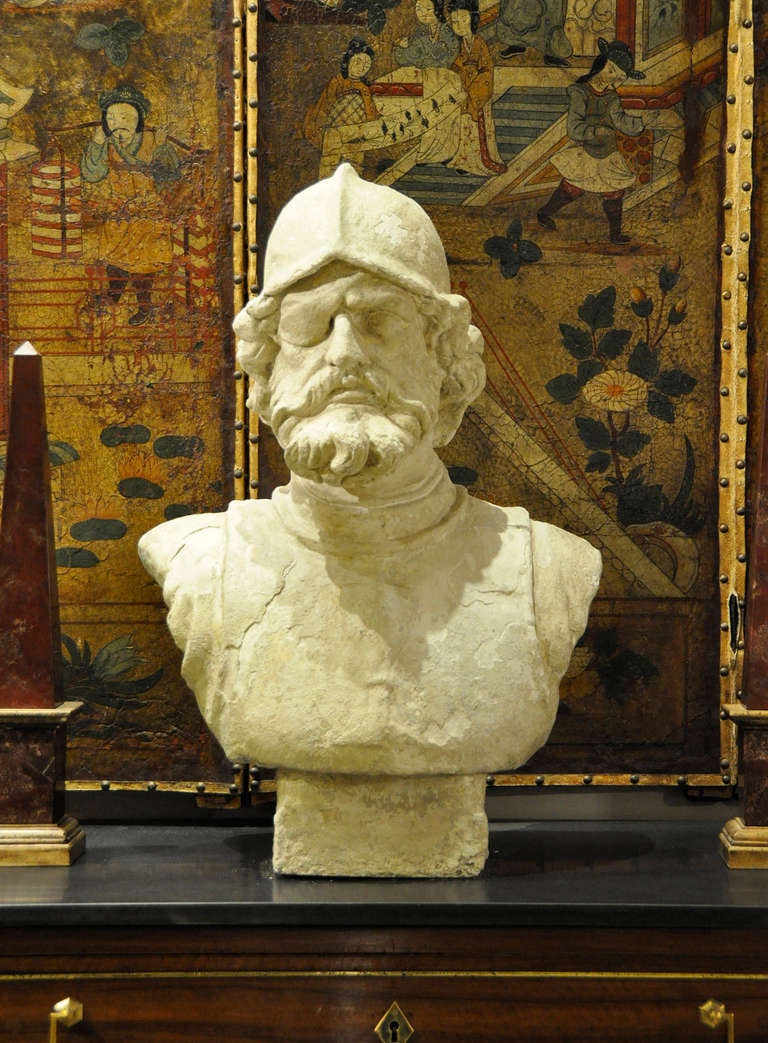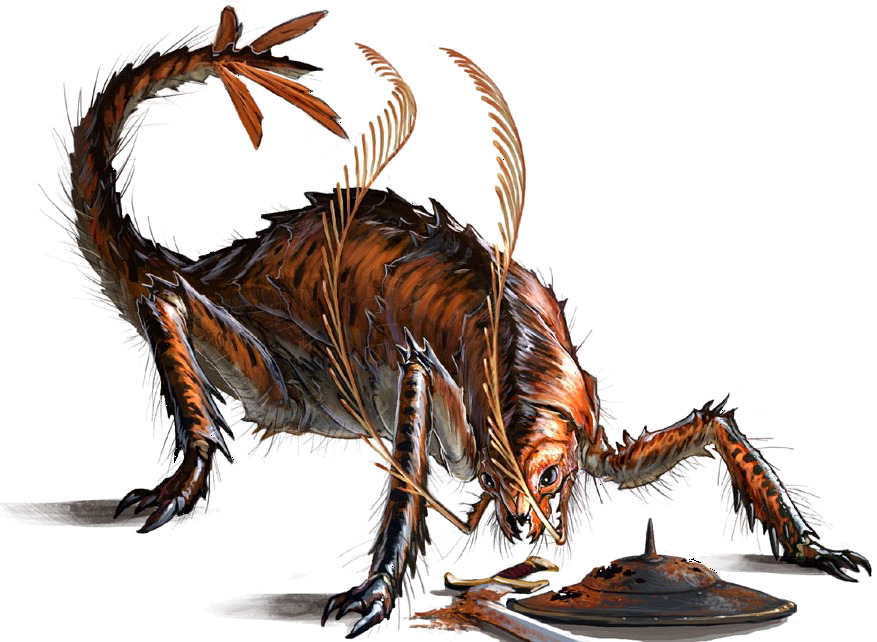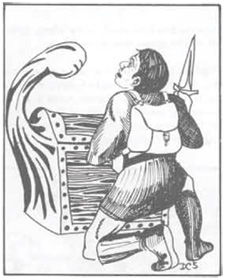In the last session, the party ran from the reaper (again) got cut down to size by a suit of animated armor, received a formal wedding invitation from the Countess, found the Lakeside Chapel, and their biggest find yet; the Libram of Heinous Damnation. With almost all of their hirelings dead or lost in the dungeon, will they delve further? How will they prepare for the wedding two weeks from now? Will the wizard sell his soul? Find out in this week's session of Castle Xyntillan!
The Party
Longo Lightfoot, Halfling Thief, wears a sky-blue headscarf. Played by CaptainSabatini.
Corby the Joyful, Human Cleric of Sucellus, wears a short, conical hat. Played by diregrizzlybear.
Idred the Most Omniscient, Human MU, wears a full-visored greathelm. Played by David Perry.
Boroth Swinney the Joyous, Human Fighter, wears a masked helm depicting a happy human face. Played by Justin Hamilton.
Francois, Light Footman, noticeably dogless.
Longo Lightfoot, Halfling Thief, wears a sky-blue headscarf. Played by CaptainSabatini.
Corby the Joyful, Human Cleric of Sucellus, wears a short, conical hat. Played by diregrizzlybear.
Idred the Most Omniscient, Human MU, wears a full-visored greathelm. Played by David Perry.
Boroth Swinney the Joyous, Human Fighter, wears a masked helm depicting a happy human face. Played by Justin Hamilton.
Francois, Light Footman, noticeably dogless.
Dominique, Heavy Footman, absolutely fanatical about the party.
Hilda, Heavy Footman, an ex-miner.
Rodolfo, Heavy Footman, running from a warrant in town.
Hubert, Heavy Footman.
Gwynefa, Arbalist.
Herman, Arbalist, escaped convict from Chamrousse.
Farida, Arbalist.
Eckhart, Lightbearer.
Bruno, Light Footman, a talented sharpshooter.
Raymond, Mule.
Raymond, Mule.
Casualties
Dominique, Beatrice Langlois-Malevol
Loot
Pearl necklace, 1250gp
Dominique, Beatrice Langlois-Malevol
Loot
Pearl necklace, 1250gp
Amber fossil brooch, 1100gp, possibly magical
The Game




- Soon after recovering the Libram, the party got down to a further investigation of the chapel. They searched the floor, walls and altar in search of secret doors or passages, but found nothing. They took a closer look around the garden outside the chapel. The blighted patch of grass was an object of interest, but they weren't sure if they wanted to dig up whatever was buried underneath. The marble statue nearby had its fingers broken off, and the lower section was worn smooth.
Idred: Are the hands at reach of goat level?
Longo: So who's going to taste it?
- Nearby, a set of stairs carved into the cliffside led down to a gondola, and a lake cave underneath the chapel. The party noted this and left it alone for the moment.

- By then, the sun hung low in the sky, and the remains of the party bailed. They headed out via the south entrance, said their goodbye to James and exited without being pursued by any grim reapers.
Longo: Hey James, don't forget about those rooms!
- They returned to the wagon to find Bruno roasting some hares for dinner. They briefed him on the events of the past few hours and camped out the night at some distance from the castle. None of their lost companions found their way back.
- At the same time, Idred and Corby discussed the Libram. The ritual it detailed would grant substantial power to a cleric or magic-user, in exchange for their eternal soul.
Idred: I’m talking metaphysics with Corby.
Corby: I’m disgusted and would never take part in this!
- Idred deeply considered using the ritual, but delayed it for the moment. The party returned late at night to Tours-en-Savoy and crashed in their rooms.
- The next day they got down to a flurry of activity. They went down to Mordecai's Curio shop and presented the Libram to him. He bugged out, and offered them a fair price for it if they handed it over to him immediately. His assistants pulled out an ensorcelled chest wrapped in chains. With some reluctance, Idred handed it over, and the Libram went in, shielded from divination and the wrath of its previous owner.

- He wrote them a cheque for the local bank. He also offered the party a selection of curios, including some valuable extras recently extracted from the southern crusades. The [party ended up picking out a gorgeous shield bearing a fleur-de-lis pattern, a Damascus steel dagger and a set of crossbow bolts fletched with the feathers of rare birds. Also some rat poison and lavender oil, which they intended to use on the frog in some way.
- They sought out the family of their lost and dead companions. Most were mercenaries from abroad, but Lisette had elderly parents on a farm nearby, and Willemot had extended family in town. The party pooled together to send them an anonymous cash gift.
- They visited Giacomo in the hospital. He was up and walking about, albeit with a cane, and was fiddling with a stud in his ear.
- They set about recruiting and rebuilding their ranks. They were in a hurry, so their new hires included several folks of a more criminal bent, but they weren't complaining. Many of the new hires were also in excellent spirits and ready to venture forth.
- That night, they tracked down Claude Malevol in the Black Comedian.
Claude: Ah, so you're the unnamed attendants.
Party: Unnamed?!
- He had also received his wedding invitation, and sat the party down. He gave them some background on the other family members: Serpentina, the succubus, Beatrice, the ghoul, Maltricia's husband Giscard, and the goats, which he revealed were experimental crossbreeds with cockatrices.
Party: Ohhhhhhh shit.
- He gave his two cents on Maltricia's plan; she wants to give the party advantages, choosing the enchanted chapel on the lake, avoiding direct combat, giving them an audience, handicapping herself, in order to make the party's eventual defeat and humiliation all the more impressive.
- They drank into the night and made plans to attend the wedding together. The next day, the party set out with a new crew.
- Looking at all their loose ends, they decided to go back to the Gothic Wing, and immediately come face-to-bust with Medard Malevol.

Medard: Two weeks! TWO WEEKS, and you haven't killed a single one of my brethren. What cowards you are!
Longo: That's true.
- Medard informed them that he hadn't seen movement in this corridor recently, except for the help. In a nearby room, headless servants presented trays of mulled wine, and a suit of armor in the corner had an arrow sticking out of its knee. Boroth made fun of it. and the suit laid a curse against him; which was luckily absorbed by his lucky horseshoe, which crumbled to ash.
- Soon afterwards a man walked in, took a seat and a glass of wine. He was dark robed, bearded and wearing a crown of thorns.
Longo: Oh no, it's a Jesus!
- The man drank disinterestedly, answering the party's questions brusquely. He was Runcius Malevol, and his domain was the forest of Castle Xyntillan.
Party: Are you concerned with bandits in your forest?
Runcius: They haven't come into my domain as of yet, so I have no quarrel with them.
Party: So you must frequent the forests south and east of the Castle?
Runcius: That is not my domain, no.
Idred: Well, we'll hope to see you if we do stumble onto your woods.
Runcius: Boy, if you stumbled into my woods, you would know it.

- Runcius left and took a corridor to the north, which the party hesitated to follow. They instead continued past the seance room where they had made their first windfall. They encountered a nook with the statue of a caveman, opposite a glorious gothic privy. They surmised that the pit underneath led to the toilet they had seen in their first expedition.
- The sound of sobbing could be heard beyond a nearby door. Making their way inside, they found a lady's boudoir, bedecked in purple drapes. The sobbing came from behind a dressing screen, and peeking around it the party found a padlocked coffin. Taking the gamble on opening it, Longo undid the lock.
- Out jumped a shriveled-up ghoul in the tattered remains of a wedding dress. This was Beatrice Langlois-Malevol, the junior bridesmaid whom Claude had just briefed the party about!
- Beatrice lunged forward, calling out for help. The party's arbalists launched a volley, but ii wasn't enough to put her down. With lethal speed, her claws ripped through Dominique in the first row, and almost did the same to Boroth. The heavy infantry retaliated with spears, and Hilda made the decisive thrust, killing Beatrice.
- But the fight wasn't over. Heavy footsteps came down the corridor, the sound of a squadron of undead ladies bearing down on the party. Another volley of bolts and darts tore through the oncoming undead, and they were held off in melee long enough for Corby to unleash his clerical light. The three remaining undead made a hasty retreat while the party shot at their backs, but might return quickly.
- Looting in peace while they could, the party found two items of note in the coffin; a valuable pearl necklace, and an amber brooch containing a fossilized lizard. It sparkled with an octarine light, possibly magical.
- They also took a moment to decapitate the ghoul's corpse, a measure against it possibly rising again. With the undead ladies possibly about to return, a step taken towards Medard's quest, some substantial loot and one hireling down so soon into the expedition, the party ended the session.
Takeaways
The bulk of this session took place in town, recruiting hirelings, shopping, updating sheets. I got ahead of the curve by pre-generating the quirks and morale modifiers for the hirelings, anticipating that they would be hiring. I could have saved some time by also generating the curio items ahead of time.
Combat has been rare enough so far that I've almost forgotten the sequence of combat. I caught myself halfway, but I actually rolled the enemy melee round before the player movement and missile round.
Talking to Claude was the big infodump, delivering information on the guests and the meaning of Maltricia's plot.
Before leaving, for the new expedition, Longo suggested that Idred cast Continual Light on an item to use as a backup. I looked up the spell, and found that it was a bit more powerful than I expected. Not only does it illuminate an object until dispelled, the light extends for 120 feet, and has all the properties of sunlight. In essence, the party could create a no-vampires-allowed zone for up to 120' in line of sight, forever, plus getting free torchlight. I'm committed to running this game as by the book as I can, so the spell stays as it is, and the vampires are going to have to be a bit smarter around the party.
Next Chapter: The Party's Pre-Wedding Plunder




























